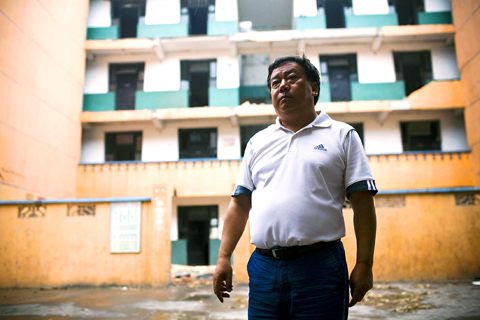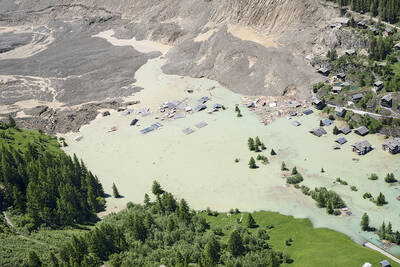In the minutes after the May 12 earthquake, the students lined up row by row on the outdoor basketball courts of Sangzao Middle School. When the head count was complete, their fate was clear: All 2,323 were alive.
Parents covered in blood and dust hugged them and cried. So did the school principal, Ye Zhiping.
“That was the single most joyful thing,” he said.

PHOTO: NY TIMES NEW SERVICE
Given that some 10,000 other children were crushed in their classrooms during the devastating quake, the survival of so many students in Sangzao counts as a minor miracle. Students and parents credit that to the man they call “Angel Ye.”
Nervous about the shoddiness of the buildings, Ye scraped together US$60,000 to renovate it in the 1990s. He had workers widen concrete pillars and insert iron rods into them. He demanded stronger balcony railings. A bathroom whose pipes had been weakened was demolished.
His school in Peace County was very likely to have withstood the 8-magnitude earthquake because he pushed the county government to upgrade it. Just 32km north, the collapse of Beichuan Middle School buried 1,000 students and teachers.
Ye’s tale sheds light on the lax building codes in this mountainous corner of Sichuan Province and what might have been done to address well-known shortcomings. In his case, a personal commitment and a relatively petty amount of cash sufficed to avert tragedy.
“We learned a lesson from this earthquake: The standards for schools should have been improved,” Ye, 55, said in a recent interview. “The standards now are still not enough.”
PREPAREDNESS
Ye not only shored up the building’s structure, but also had students and teachers prepare for a disaster. They rehearsed an emergency evacuation plan twice a year. Because of that, students and teachers say, everyone managed to flee in less than two minutes on May 12.
“We’re very thankful,” said Qiu Yanfang, 62, the grandmother of a student, as she sat outside the school knitting a brown sweater. “The principal helped ease the nation’s loss, both the psychological loss and the physical loss.”
Sangzao is a farming town of 30,000 where merchants sell vegetables from blankets on a rutted market road. It has two middle schools, one administered by the township, where a dormitory collapsed during the earthquake, and the other administered by the county. Ye works in the second, where families from across northern Sichuan send their children because of the school’s reputation.
A large billboard on the school grounds lists the names of 90 students who earned top scores on a national exam last year.
SHODDY CONSTRUCTION
The school is one of the largest in Peace County. It has a half-dozen dormitory buildings and two classroom buildings, all five stories or lower. One of the classroom buildings was constructed after 2000, the other between 1983 and 1985.
The older one worried Ye when he became principal 12 years ago.
It is a four-story white building with large, tinted-glass windows and blue, metal railings running along balconies onto which classrooms open.
“Quality inspectors were supposed to be here to oversee construction of this building,” he said. “When the foundation was laid, they should have been here. When the concrete was put into the pillars, they should have been here. But they weren’t.”
“In the end, no government official dared to come inspect this building because it was built without any standards,” he said.
Ye walked down the hallways with a visitor and pointed to the corners where ceiling met wall. He said workers had stuffed canvas bags and trash into those crevices to seal them. In addition, he said, the surfaces of the walls were coarse rather than smooth, a sign of shoddy construction.
The balcony railings were originally made of cement, not metal. They were shaky and too short, Ye said. They also lacked vertical pillars for support.
“I was among the first teachers who moved into this building, and I was pretty young,” Ye said. “Our awareness of safety wasn’t the same as now.”
TIME TO ACT
He said his attitude changed after he became principal.
“If I knew there was a hidden danger, and I didn’t do anything about it, then I would be the one responsible,” he said.
From 1996 to 1999, Ye oversaw a complete overhaul.
He said that he pestered county officials for money. Eventually the education department gave a total of US$58,000. It was a troublesome process because the county was poor and thus tight with money, Ye said, but officials saw the need to ensure the safety of children.
These days, students dart in and out of the school to grab textbooks, ducking beneath a thin blue ribbon with a handwritten sign that says “Danger.” To them, the building seems sturdy enough.
But Ye said it will be torn down, never again used for classes.

The collapse of the Swiss Birch glacier serves as a chilling warning of the escalating dangers faced by communities worldwide living under the shadow of fragile ice, particularly in Asia, experts said. Footage of the collapse on Wednesday showed a huge cloud of ice and rubble hurtling down the mountainside into the hamlet of Blatten. Swiss Development Cooperation disaster risk reduction adviser Ali Neumann said that while the role of climate change in the case of Blatten “still needs to be investigated,” the wider impacts were clear on the cryosphere — the part of the world covered by frozen water. “Climate change and

Poland is set to hold a presidential runoff election today between two candidates offering starkly different visions for the country’s future. The winner would succeed Polish President Andrzej Duda, a conservative who is finishing his second and final term. The outcome would determine whether Poland embraces a nationalist populist trajectory or pivots more fully toward liberal, pro-European policies. An exit poll by Ipsos would be released when polls close today at 9pm local time, with a margin of error of plus or minus 2 percentage points. Final results are expected tomorrow. Whoever wins can be expected to either help or hinder the

DENIAL: Musk said that the ‘New York Times was lying their ass off,’ after it reported he used so much drugs that he developed bladder problems Elon Musk on Saturday denied a report that he used ketamine and other drugs extensively last year on the US presidential campaign trail. The New York Times on Friday reported that the billionaire adviser to US President Donald Trump used so much ketamine, a powerful anesthetic, that he developed bladder problems. The newspaper said the world’s richest person also took ecstasy and mushrooms, and traveled with a pill box last year, adding that it was not known whether Musk also took drugs while heading the so-called US Department of Government Efficiency (DOGE) after Trump took power in January. In a

It turns out that looming collision between our Milky Way and Andromeda galaxies might not happen after all. Astronomers on Monday said that the probability of the two spiral galaxies colliding is less than previously thought, with a 50-50 chance within the next 10 billion years. That is essentially a coin flip, but still better odds than previous estimates and farther out in time. “As it stands, proclamations of the impending demise of our galaxy seem greatly exaggerated,” the Finnish-led team wrote in a study appearing in Nature Astronomy. While good news for the Milky Way galaxy, the latest forecast might be moot